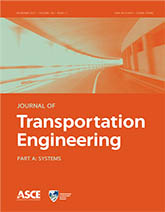
An existing vehicle dynamics model was used to define design parameters up to which steady-state cornering conditions apply and consequently lift the restrictions of the point mass model. Besides a passenger car, the motion of a two-axle truck was examined as well for both loaded and unloaded conditions. In order to assess critical safety concerns in terms of vehicle skidding, a range of design speed values paired with control design elements from standard design guidelines as well as certain values of peak friction coefficients were used. The unloaded truck was found to be the most critical vehicle in terms of reaching a maximum constant speed, termed as safe speed. Furthermore, the authors provide modeling examples toward the development of a tool for practitioners to concurrently assess the impact of road geometry and friction in terms of defining the vehicle’s safe speed and, consequently, take certain actions. These actions include the adoption of acceptable arrangements for the above values, as well as scheduling accurate friction improvement programs.
| ID | pj130 |
| Manuscript | |
| DOI | |
| Tags |













